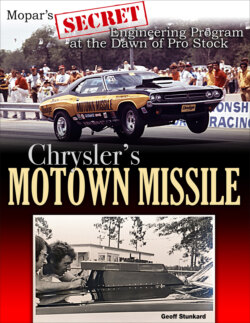Chrysler's Motown Missile: Mopar's Secret Engineering Program at the Dawn of Pro Stock

Реклама. ООО «ЛитРес», ИНН: 7719571260.
Оглавление
Geoff Stunkard. Chrysler's Motown Missile: Mopar's Secret Engineering Program at the Dawn of Pro Stock
The Team
The Experts
The Shooters
The Car Owners and Friends
Dedication
Science Class
En Route to Pro Stock
Pro Stock’s First Rules
Express Travel to Dodge City
Performance Automotive
Before the Motown Missile
Pro Stock Racing Through May 1970
On and Off the Drawing Board
First to the IR
Then a Clutch Play
Into the Record Books and First Time Out
Three to Six–The Big ’Flite
Feel the Light
Success at First, But the Show Goes On
Testing Continues
Grand Finales
Working for a Living
Rocket Science
Winter Racing Recap
Don with a Clutch and a National Event Win
Summertime Blues and Another Big Win
Testing Continues
The 1971 Test Results
Indy, NHRA in Amarillo, and IHRA’s First World Championship
The End of an Era
Performance Automotive to SVI
The Motown ’Cuda
Before Pomona: The Shape of Things to Come
Winternationals of Discontent
Testing 1-2-3
Chomping at Gainesville
Spring and More
Missile Tests Continue
Oh, Boy(cott)
Meanwhile, the IHRA Continues On
A Final Look at 1972
That Butler Guy
Florida Flyer Cover Car
A Little Less Engine, Please
That Pappas Guy
On to the Races
NHRA and IHRA:Florida Follies and Their Aftermath
Nothing Changes
Tricks of the Trade
Test Time
Spring Has Sprung
Indy 1973 and NHRA Season End
IHRA World Championship #3
Wild Horses
The Yellow Car
Real Time Data Recording
At the Shop
LA-Engine Efforts
Racing 1974: Part 1
Final Frontier: The Wire Car
Racing 1974: Part 2
In the End, the End
Southern Nights: Don Carlton and the Post-Factory Era
The Spirit of 1976
The First Half: 1977
July 5
A Final Requiem: The Last NHRA World Championship of the 1970s
1970–1971 Dodge Challenger: Spehar/Oldfield/Koran/Chrysler Engineering
1972 Plymouth Barracuda: Spehar/Oldfield/Koran/Chrysler Engineering
1973 Plymouth Duster: Butler/Oldfield/Chrysler Engineering
1972 Demon/1974 340 Yellow Test Car: Hodges/Oldfield/Pappas/Chrysler Engineering
1974 Plymouth Duster Wire Car: Knapp/Adam/Pappas/Oldfield
1972 Colt: Knapp/Butler/Pappas/Oldfield/Hodges
The “Hodges Dodges” Pro Stocks and More
Отрывок из книги
Table of Contents
Acknowledgments
.....
So, going into their biggest event of the year, the NHRA decided to catch the racers at their own game. This was when the NHRA stated that at Indy every run down the track could become the index for Monday’s finals. Since only the class winner and runner-up from Saturday afternoon’s class runoffs were allowed to advance to race in Monday’s final eliminations, these new racing indexes would obviously be derived from the fastest runs made during that weekend. This was because the NHRA assumed every driver would have to run flat out to win a class crown. Still, to make it fair, they also agreed that the index would not change again on Monday. For the first time, drivers could run flat out all day and the record rule would not apply until the final. In the final round, the drivers could run as fast as necessary, but that fast time was the new index heading into the following event.
On Friday morning, the Chrysler racers slowly left town, heading for a little track just over the Ohio state line a couple of hours east. Dave Koffel rented the track with his American Express card, and now each of the three-dozen-plus drivers arriving there would make three passes to see who was truly fastest. The two best in each class would then return to Indy to run for the class win and runner-up slots. Once Chrysler had determined who the fastest guys were fair and square (away from the oversight of NHRA officials), the three chosen duos in SS/B, SS/BA, and SS/CA (all Hemi cars exclusively) returned to Indianapolis and basically cruised downtrack on Saturday for the class battle and “new” records. The predetermined faster car from the so-called “Mini-Nationals” also deliberately ran slower to be the class runner-up, all of which kept the old indexes used before the Nationals completely intact. Meanwhile, the other guys fought each other hard, and most had killed or reset their indexes when clocking their best possible number round after round in taking class victories. For their part, Hoover, Maxwell, and factory race boss Bob Cahill wandered around the Indy pits on Friday morning, shrugging off questions about where all the absent racers had gone.
.....